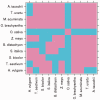Triticeae resources in Ensembl Plants
- PMID: 25432969
- PMCID: PMC4301745
- DOI: 10.1093/pcp/pcu183
Triticeae resources in Ensembl Plants
Abstract
Recent developments in DNA sequencing have enabled the large and complex genomes of many crop species to be determined for the first time, even those previously intractable due to their polyploid nature. Indeed, over the course of the last 2 years, the genome sequences of several commercially important cereals, notably barley and bread wheat, have become available, as well as those of related wild species. While still incomplete, comparison with other, more completely assembled species suggests that coverage of genic regions is likely to be high. Ensembl Plants (http://plants.ensembl.org) is an integrative resource organizing, analyzing and visualizing genome-scale information for important crop and model plants. Available data include reference genome sequence, variant loci, gene models and functional annotation. For variant loci, individual and population genotypes, linkage information and, where available, phenotypic information are shown. Comparative analyses are performed on DNA and protein sequence alignments. The resulting genome alignments and gene trees, representing the implied evolutionary history of the gene family, are made available for visualization and analysis. Driven by the case of bread wheat, specific extensions to the analysis pipelines and web interface have recently been developed to support polyploid genomes. Data in Ensembl Plants is accessible through a genome browser incorporating various specialist interfaces for different data types, and through a variety of additional methods for programmatic access and data mining. These interfaces are consistent with those offered through the Ensembl interface for the genomes of non-plant species, including those of plant pathogens, pests and pollinators, facilitating the study of the plant in its environment.
Keywords: Comparative genomics; Functional genomics; Genetic variation; Genome browser; Transcriptomics; Triticeae.
© The Author 2014. Published by Oxford University Press on behalf of Japanese Society of Plant Physiologists.
Figures






Similar articles
-
Ensembl Plants: Integrating Tools for Visualizing, Mining, and Analyzing Plant Genomics Data.Methods Mol Biol. 2016;1374:115-40. doi: 10.1007/978-1-4939-3167-5_6. Methods Mol Biol. 2016. PMID: 26519403
-
Ensembl Plants: Integrating Tools for Visualizing, Mining, and Analyzing Plant Genomic Data.Methods Mol Biol. 2017;1533:1-31. doi: 10.1007/978-1-4939-6658-5_1. Methods Mol Biol. 2017. PMID: 27987162
-
Ensembl Genomes 2013: scaling up access to genome-wide data.Nucleic Acids Res. 2014 Jan;42(Database issue):D546-52. doi: 10.1093/nar/gkt979. Epub 2013 Oct 25. Nucleic Acids Res. 2014. PMID: 24163254 Free PMC article.
-
Unlocking Triticeae genomics to sustainably feed the future.Plant Cell Physiol. 2013 Dec;54(12):1931-50. doi: 10.1093/pcp/pct163. Epub 2013 Nov 6. Plant Cell Physiol. 2013. PMID: 24204022 Free PMC article. Review.
-
Triticeae genomics: advances in sequence analysis of large genome cereal crops.Chromosome Res. 2007;15(1):21-31. doi: 10.1007/s10577-006-1107-9. Chromosome Res. 2007. PMID: 17295124 Review.
Cited by
-
Development and use of miRNA-derived SSR markers for the study of genetic diversity, population structure, and characterization of genotypes for breeding heat tolerant wheat varieties.PLoS One. 2021 Feb 4;16(2):e0231063. doi: 10.1371/journal.pone.0231063. eCollection 2021. PLoS One. 2021. PMID: 33539339 Free PMC article.
-
The Cer-cqu gene cluster determines three key players in a β-diketone synthase polyketide pathway synthesizing aliphatics in epicuticular waxes.J Exp Bot. 2016 Apr;67(9):2715-2730. doi: 10.1093/jxb/erw105. Epub 2016 Mar 9. J Exp Bot. 2016. PMID: 26962211 Free PMC article.
-
Genome-wide identification and analysis of wheat LRR-RLK family genes following Chinese wheat mosaic virus infection.Front Plant Sci. 2023 Jan 17;13:1109845. doi: 10.3389/fpls.2022.1109845. eCollection 2022. Front Plant Sci. 2023. PMID: 36733595 Free PMC article.
-
A novel allele of TaGW2-A1 is located in a finely mapped QTL that increases grain weight but decreases grain number in wheat (Triticum aestivum L.).Theor Appl Genet. 2018 Mar;131(3):539-553. doi: 10.1007/s00122-017-3017-y. Epub 2017 Nov 17. Theor Appl Genet. 2018. PMID: 29150697 Free PMC article.
-
Homoeologs: What Are They and How Do We Infer Them?Trends Plant Sci. 2016 Jul;21(7):609-621. doi: 10.1016/j.tplants.2016.02.005. Epub 2016 Mar 22. Trends Plant Sci. 2016. PMID: 27021699 Free PMC article. Review.
References
-
- Allen AM, Barker GLA, Berry ST, Coghill JA, Gwilliam R, Kirby S, Robinson P, et al. Transcript-specific, single-nucleotide polymorphism discovery and linkage analysis in hexaploid bread wheat (Triticum aestivum L.) Plant Biotechnol. J. 2011;9:1086–1099. - PubMed
-
- Bennett MD, Smith JB. Nuclear DNA amounts in angiosperms. Philos. Trans. R. Soc. B: Biol. Sci. 1991;334:309–45. - PubMed
Publication types
MeSH terms
Grants and funding
LinkOut - more resources
Full Text Sources
Other Literature Sources

